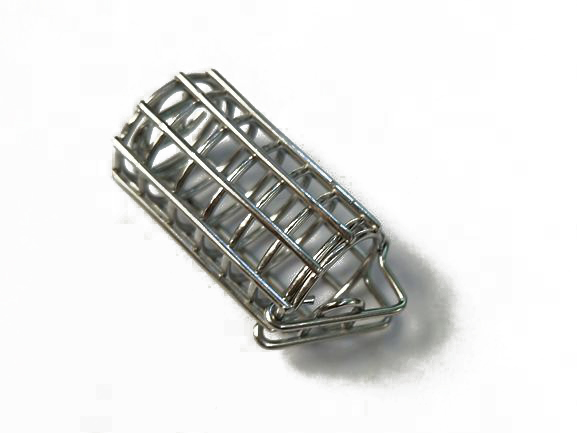Japanese sinker specifications and inquiry links: Dissolution sinker
Recently, many customers have asked about the Japanese sinker. I will introduce it in detail today. The second part is about the difference between paddle and basket in dissolution.

Material: SS316 or Material specially treated - Our patented technology
Inside length : 23.7 mm
Inside diameter: 11.9 mm
Wire diameter : 0.99 mm
Of course, the specifications are customizable.
A Japanese sinker is an important tool in a dissolution test of capsules and tablets. When you buy, pay attention to testing its quality.
(This part is excerpted from 《In vitro models for the prediction of in vivo performance of oral dosage forms》
The author is Edmund S. Kostewicz, Bertil Abrahamsson, Marcus Brewster, Joachim Brouwers, James Butler, Sara Carlert, Paul A. Dickinson, Jennifer Dressman, Renei Holm, Sandra Klein, James A. Dickinson, Marker, Miners, Muekenster, An Uister, and other scientists from AstraZeneca, Johnson & Johnson, GSK, MSD, Pfizer, Bayer and other companies and universities. Ette M llertz, Miriam Verwei, Maria Vertzoni, Werner Weitschies, Patrick Augustijns)
Dosage form
In principle, paddle and basket methods can be used in all oral dosage forms. In the dissolution test of oral liquid, both Japanese sinker and dissolution basket is used. It needs to be chosen according to the actual situation.
For IR drugs, in general, no additional hardware is required when the tablets are tested by paddle method. Capsules usually need a settling device (Sinker) to keep the capsules in the medium or use basket method.
- The settling device mentioned here is called Japanese sinker or capsule sinker.
When studying the release characteristics of enteric coated (EC) drugs, basket method is easier to operate from stomach to intestine.
For example, when removing or replacing media. Even though enteric coated (EC) drugs consist of pellets, basket method is usually not a problem.
The paddle method and basket method can be used for the determination of release preparations (MR).
Because it is difficult to change the medium many times in the paddle method and basket method, it is difficult to track the preparation that changes the performance of the preparation in the gastrointestinal tract by the paddle method or basket method.
Therefore, due to the lack of flexibility in changing the composition of the medium, the paddle method or basket method commonly used for quality control (QC) may not have the much in-vitro and in-vivo correlation.
Medium
The propeller method and basket method usually use the medium volume of 500-1000ml, which helps to produce the leaky groove condition for dissolving drugs, which is a requirement for meeting the key quality control objectives. It shows that the drug can be completely released from the preparation.
However, these volumes may have nothing to do with the body's condition, depending on whether the drug is taken with food.
In the early to the mid digestive stage of the stomach, the volume may be close to 1L or larger. However, if the drug is taken with a glass of water on an empty stomach, the volume of the stomach is unlikely to exceed 250 ml, so the volume used in the dissolution test may be too large to accurately reflect the condition of the stomach (Schiller et al., 2005).
For BCS I and III drugs, even in small volumes, the leaky groove condition may be satisfied. The difference between the volume of dissolving media and the volume of a fasting stomach is unlikely to be a problem.
However, for insoluble drugs, the use of large volumes in dissolution may lead to an overestimation of stomach volume.
As far as intestinal conditions are concerned, the volume is not the only factor affecting whether leaky groove conditions can be produced. When the drug is absorbed, the drug in the solution will be reduced by the ingestion of the intestinal wall, and can also produce a leaky groove condition.
Therefore, the need to use leaky strips in vitro depends on the permeability and solubility of the drug.
For insoluble drugs, compared with low permeability drugs (BCS IV), paddle method and basket method are more suitable for dissolution test of BCS II drugs in the small intestine.
If the dosage of the drug is appropriate, the dissolution test can combine the small volume of the dissolution medium with the specially designed paddle and small dissolution cup.
In this case, the minimum volume available is about 200 ml, which is especially suitable for dissolution of BCS IV drugs under simulated gastrointestinal or small intestinal fasting conditions.
Klein et al. have shown that the hydrodynamics of propellers is appropriate for propeller method (Klein and Shah, 2008). However, propellers have not yet been formally included in any pharmacopeia, and their design and size have not been coordinated among manufacturers.
That's all for today.
The second part is not the result of ZHEHAN's research. Here I would like to emphasize it again.
The author has already written it in the article, if you have any questions, please let me know.
Finally, I would like to pay the highest tribute to those great scholars.
In addition, I can leave a message about the Japanese sinker.
Application of Basket Strainers in Conductive Agent Production
View More >Applicaton of Self-cleaning filter
View More >Copyright © Hebei Huanzheng Filter Equipment Co., Ltd. All Rights Reserved